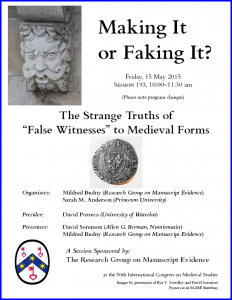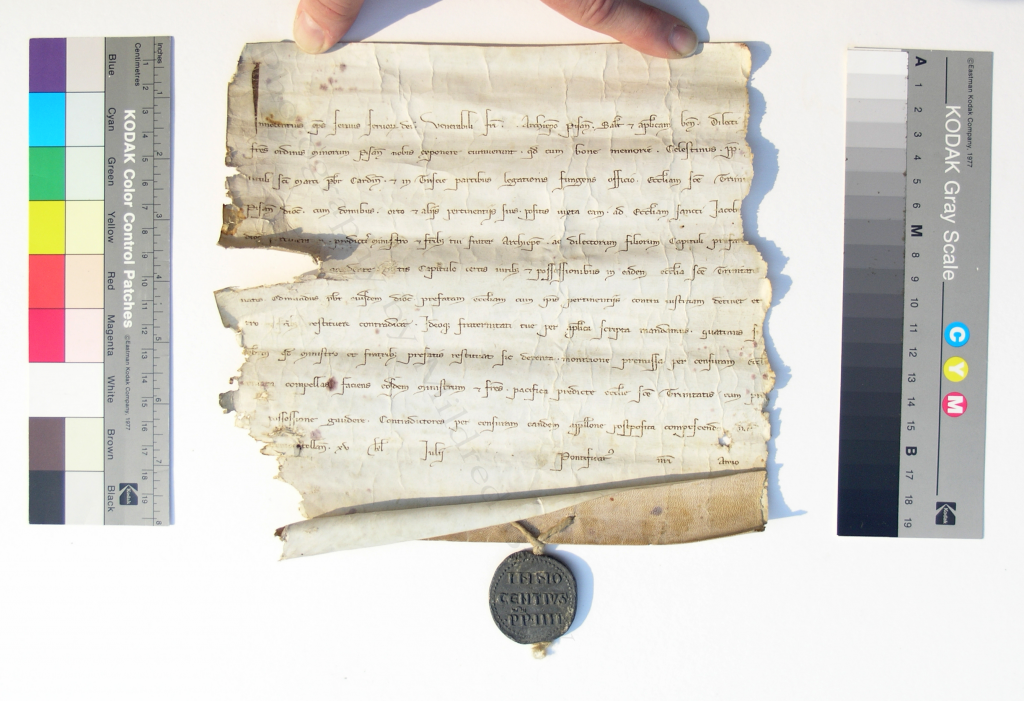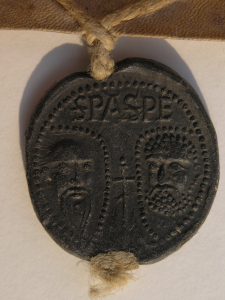Mildred Budny
(Research Group on Manuscript Evidence)
“The Truth Will Out:
Verity or Verisimilitude in Pre-Photographic Reproductions”
 Abstract of Paper Presented at the 50th International Congress on Medieval Studies (Kalamazoo, 2015)
Abstract of Paper Presented at the 50th International Congress on Medieval Studies (Kalamazoo, 2015)
Session on “Making It or Faking It? The Strange Truths of ‘False Witnesses’ to Medieval Forms”
Sponsored by the Research Group on Manuscript Evidence
Organized by Mildred Budny and Sarah M. Anderson
2015 Congress Events Announced and 2015 Congress Events Accomplished
[Published on 25 March 2015, with updates]
Awareness of the truth or falsehood of witnesses to medieval forms, whether they may be of the time or from a later time than the stated or implied date, deserves continued vigilance. Not only does research continue to advance, sometimes relentlessly, in order better to understand the testimony of specific witnesses for what they are, but also the increasing attention nowadays to the evidence, both written and unwritten, in its many forms and aspects, brings to light new materials and new recognition or re-evaluation of materials long in the limelight which deserve re-evaluation for their newly suspect testimony.
This paper explores some contradictions inherent in the exploration of such tensions between testimony and the methods of recognition of its veracity (or not). In a law-court, the validity of testimony in one form or another may rest upon determining its truth or falsehood, in whatever measure or combination. For example, the truth of a particular witness might be that it is false, or false in some specific degree. The question for assessing the complex testimony of medieval forms might reside principally in discerning the degree (or degrees) to which they represent their own ‘chosen’ time and another time or set of times, both prior and (it may be) subsequent.
Some cases in point may reveal telling points on a spectrum of choice which could, within a single witness, both conceal and reveal the time and place of origin in question. Pre-photographic reproductions (of many kinds and dates) may offer central challenges for evaluation. The selected cases include examples which may test some of our customary assumptions about the ability of ‘forgeries’, ‘reproductions’, ‘facsimiles’, and other modes of reconstruction or re-creation to represent the ‘originals’ which they reproduce, in one form of ‘veracity’ or another. Useful and perhaps even central to this discourse is the awareness that most medieval manuscripts (to select one complex medium among many) themselves constitute ‘facsimiles’, to some extent, of earlier forms.
Curiously, some of those degrees of ‘reproduction’ rather than original ‘creation’, take a long time to recognize. A cautionary tale may reside in the strange fates of some pre-photographic reproductions of manuscripts or other media not only in the early modern period and beyond, but also during the Middle Ages themselves. Specimens for consideration include works by the entymologist–antiquary John Obadiah Westwood (1805–1893) and the anonymous 9th-century creator of the Liber Commonei (‘Book of Commoneus’) in Saint Dunstan’s [so-called] Classbook. Methods of reproduction by transfer which imposed damage on the originals have a place in the story, as with the stylus tracings over major illustrations ranging from the late-antique Vatican Vergil while at Tours in the 840s, as an inspiration for the Vivian Bible, to the Corpus portion of the 8th-century Insular Cambridge—London Gospels presumably while undergoing reproduction in 1847.
Detailed examination and comparison of works in question (which might be any works whatsoever under consideration) may sometimes reveal significant evidence for indicating or establishing the authenticity or forgery of materials, ranging from the linguistic and palaeographic features of charters at St. Augustine’s Abbey, Canterbury, to the numbers of dots used to render the hair, beard, or aureoles of Saints Peter and Paul on papal bullae.
[A case in point(s) focused upon some bullae of Pope Innocent IV (1243‒1254), with a view to their authenticity or otherwise. The principal focus was the lead bulla on the copy of a letter which this Pope addressed to the Franciscans in Pisa, now in private hands. The document is an on-going subject of research for Mildred Budny’s Illustrated Handlist (Handlist Number 18), for which a detailed Report is in preparation. Commencing with the phrase Dilecti Fratres Ordinis Minorum Pisano, and restoring to the Franciscans the Church of the Most Holy Trinity in Pisa, the document was issued on 17 June 1244 at Civitá Castellana. The copy retains its hemp cord, lead bulla, and Procter’s Mark. Real or Fake? A comparison with some other bullae, authentic and apparently forged, narrows the range.]
Some cases of reproduction may be more-or-less innocent, as with the straightforward verbatim copies of colophons with now-distant names and dates impossible for the production of the book in question. Sometimes it may be the details that tell the tale, or expose the truth or ‘truth’ of the testimony of the evidence.
A long view of the Middle Ages, their own witnesses, and subsequent reproductions of them — both photographic and pre-photographic — may enable us better to recognize the relative degrees of verity or verisimilitude in their individual representatives. We might thus not have to wait for subsequent centuries to have a head start on gaining such awareness.
*****
This paper draws on research for a variety of purposes. Some of these cases are examined in detail here:
Saint Dunstan’s Classbook
Vivian Bible
Illustrated Catalogue
*****
Abstracts of Other Papers by Mildred Budny for our Sessions and Events appear here:
“Introduction to the Symposium: The Back & Forward Story” at the 2016 Symposium on “Words & Deeds”
Budny (2016 Congress)
Budny (2015 Congress)
Budny (2014 Congress)
“When the Dust Has Settled”
“Recollections of the Past”
“Identity and Authenticity”
*****




[…] 3>2. Mildred Budny ‘The Truth Will Out: Verity or Verisimilitude in Pre-Photographic Reproductions’ Abstract of Paper […]